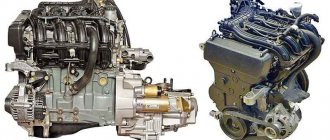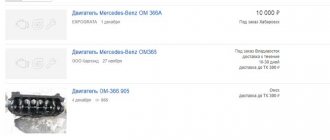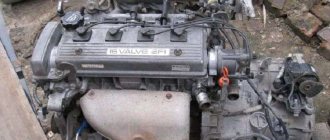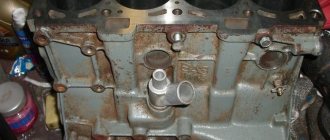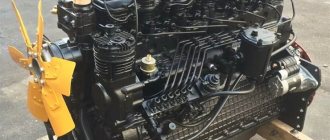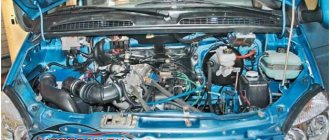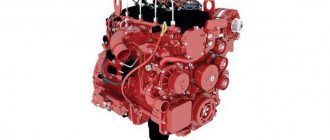Engine 21129 was created specifically for Lada Vesta and X-Ray. The main development requirements were:
- adaptation to the AMT gearbox manufactured by AvtoVAZ and manual automatic transmission from Renault;
- raise environmental standards to Euro 5;
- increase power and service life.
Of all the manufacturer's engines existing at that time, version 21127 partially satisfied these conditions. It bends the valve, but has many advantages that cover this disadvantage, which is why it became the base model for tuning, and the number of modifications became minimal.
Characteristics of motor 21129
On the one hand, the 21127 engine, which served as the base version for the creation of 21129, is in turn a tuned modification of 21126, so most of the components in the engine remained the same to reduce production costs. From another point of view, the manufacturer took into account the disadvantages of upgrading its subsidiary to the ICE 21128, so the final engine diagram looks like this:
- the cylinder diameter and piston stroke remained classic for front-wheel drive engines - 82 mm and 75.6 mm, respectively;
- the gas distribution mechanism of the engines remained unchanged - DOHC with two overhead camshafts;
- the cylinder head, connecting rod-piston group and cylinder block have not undergone any changes;
- the entire intake tract with an integrated receiver, DBP and DTV sensors instead of the mass air flow sensor has been preserved;
- the attachments have been partially changed - new pillows, generator and exhaust manifold;
- The engine cooling system and fuel injection have been improved.
The most important feature of 21129 was the new version of the ECM firmware - M86. As a result, gasoline consumption decreased, torque and power increased to 148 Nm and 106 hp. s., respectively. That is, the modernization did not affect the volume of combustion chambers of 1.6 liters.
A full description of the motor parameters is given in the instructions, and the main technical characteristics of 21129 are contained in this table:
| Manufacturer | AvtoVAZ |
| Engine brand | 21129 |
| Years of production | 2015 – … |
| Volume | 1597 cm3 (1.6 l) |
| Power | 78 kW (106 hp) |
| Torque moment | 148 Nm (at 5800 rpm) |
| Weight | 110 kg |
| Compression ratio | 10,5 |
| Nutrition | injector |
| Motor type | in-line |
| Injection | distributed electronically controlled |
| Ignition | coil for each spark plug |
| Number of cylinders | 4 |
| Location of the first cylinder | TVE |
| Number of valves on each cylinder | 4 |
| Cylinder head material | aluminum alloy |
| Intake manifold | combined with receiver, polymer, built-in damper, DTV and DBP sensors |
| An exhaust manifold | catalyst |
| Camshaft | 2 pcs., marks on pulleys are offset by 2 degrees |
| Cylinder block material | cast iron |
| Cylinder diameter | 82 mm |
| Pistons | lightweight, manufacturer Federal Mogul |
| Crankshaft | from 11183 |
| Piston stroke | 75.6 mm |
| Fuel | AI-95 |
| Environmental standards | Euro 5 |
| Fuel consumption | highway – 5.3 l/100 km combined cycle 6.6 l/100 km city – 9 l/100 km |
| Oil consumption | maximum 0.1 l/1000 km |
| What kind of oil to pour into the engine by viscosity | 5W-30 and 10W-40 |
| Which engine oil is best by manufacturer | Liqui Moly, LukOil, Rosneft, Mannol, Mobil |
| Oil for 21129 according to composition | synthetics, semi-synthetics |
| Engine oil volume | 3.5 l |
| Operating temperature | 95° |
| Motor life | declared 200,000 km actual 300,000 km |
| Adjustment of valves | hydraulic compensators |
| Cooling system | forced, antifreeze |
| Coolant quantity | 7.8 l |
| water pump | with metal impeller |
| Candles for 21129 | BCPR6ES from NGK or domestic AU17DVRM |
| Gap between spark plug electrodes | 1.1 mm |
| Timing belt | Gates, width 22 mm, service life 200,000 km |
| Cylinder operating order | 1-3-4-2 |
| Air filter | Nitto, Knecht, Fram, WIX, Hengst |
| Oil filter | catalog number 90915-10001 replacement 90915-10003, with check valve |
| Flywheel | increased damper size |
| Flywheel mounting bolts | box MT – M10x1.25 mm, length 26 mm, groove 11 mm box AT – M10x1.25 mm, length 26 mm without groove |
| Valve stem seals | code 90913-02090 inlet light code 90913-02088 exhaust dark |
| Compression | from 13 bar, difference in adjacent cylinders maximum 1 bar |
| XX speed | 800 – 850 min-1 |
| Tightening force of threaded connections | spark plug – 31 – 39 Nm flywheel – 62 – 87 Nm clutch bolt – 19 – 30 Nm bearing cap – 68 – 84 Nm (main) and 43 – 53 (rod) cylinder head – three stages 20 Nm, 69 – 85 Nm + 90° + 90° |
The developers recommended equipping the 21129 engine with the plant’s cars with the GFL12 robotic gearbox, the VAZ GFL11 manual gearbox and the Renault GFL13 manual gearbox.
Basic list of faults
As the domestic manufacturer assures, the resource of the power unit is 200 thousand kilometers while maintaining operational properties. Nevertheless, even such a perfect design of the 21127 engine does not exclude the occurrence of various malfunctions. Friction can often be observed, however, this is typical for most modern power units. This mainly indicates clogged injectors. Washing them gives the desired result.
Problems with electronics can also occur. Often the people who suffer the most are:
- ignition coil;
- starter;
- electronic control unit;
- fuel pressure or idle speed regulator.
Sometimes you can hear knocking noises from the engine compartment. You should not put off inspecting your car indefinitely; it is better to immediately determine the source of the extraneous noise. It is likely that the sounds are made by hydraulic compensators, and then there is nothing to worry about.
You should panic if the cause of the knocking is not in these parts. With a greater degree of probability, this may indicate wear of the connecting rod and piston group.
Design Features
Initially, engine 21129 retained the design of the basic version 21127:
- “tall” gray cylinder block, transferred from 11183, the surfaces of the liners are processed by honing;
- Cylinder head from modification 21124;
- gas distribution mechanism with phased injection with hydraulic compensation of thermal valve clearance;
- lightweight piston group from Federal Mogul;
- V-belt drive of timing camshafts with rounded teeth from Gates with a service life of 200,000 km;
- crankshaft with long radius crank from internal combustion engine 11183;
- fuel rail with medium-performance injectors from Bosch or Siemens;
- individual spark plug ignition coils without a high-voltage wire bundle;
- increased diameter of the damper on the flywheel;
- catalytic converter built into the exhaust tract - catalytic collector.
Thus, the manufacturer does not provide for boosting the internal combustion engine in principle. Power and torque remained the same, oil consumption within 100 g/1000 km. The manual created by AvtoVAZ designers contains step-by-step operations, thanks to which major repairs can be done with your own hands.
Advantages and disadvantages
The advantages of the 21129 engine are:
- economical consumption of coolant, engine oil and fuel;
- compliance with Euro-5 standards;
- improved attachments;
- overhaul on your own;
- declared resource 200,000 km;
- absence of periodic adjustments of valve thermal clearances.
To ensure the specified motor life, the manual recommends using only high-quality lubricants from reliable manufacturers. The disadvantages of the power drive design are:
- expensive maintenance due to the need for high-quality oil in hydraulic pushers;
- high capital repair budget due to the use of ShPG and timing belt kits from foreign companies;
- there is a danger of bending the valves if the timing belt drive breaks.
The compression ratio has decreased by 0.5 units, which seems to reduce the octane number of the fuel. In practice, the quality of domestic gasoline is unsatisfactory; experts do not recommend experimenting for dubious savings in the operating budget.
Are the valves bending?
Lada Vesta 2021 technical specifications, configurations and prices
Since the 21127 engine is built on the basis of the 21126 unit, the situation with valve bending is the same. The problem arose during the use of lightweight pistons without deep recesses on the bottoms. As a result of a broken timing belt, the camshaft stops, but the crankshaft continues to rotate by inertia, pushing the pistons up. The valve stems are bent due to a collision with the pistons, and parts can only be replaced during a major overhaul.
Knowing about the shortcoming of engine 21127, the plant initially made recommendations on maintenance regulations. Despite the declared timing belt resource of 200,000 km and an automatic tensioner, it is necessary to check the integrity of the drive and the quality of tension every maintenance. The belt can fall off not only due to natural wear, but also as a result of jamming of the idler roller or pump. In practice, the belt has to be changed after 50 - 60,000 km to prevent damage to the valve legs.
What cars was it used in?
Initially, the engine characteristics are higher than those of previous versions, so the 21129 engine is installed on modern AvtoVAZ models:
- Lada Vesta – five-door station wagon, four-door sedan;
- Lada X-Ray – five-door hatchback;
- Lada Largus is a compact cargo van, a five-door station wagon.
The compact and intuitive design of the internal combustion engine does not cause problems during maintenance and overhauls.
Maintenance
Engine 21129 must be serviced in the following order to ensure a service life of at least 200 thousand km:
- after 10–15 thousand kilometers, it is necessary to take care of replacing the engine lubricant and filter;
- every 20 thousand it is necessary to inspect the cathode collector, spark plugs, alternator belt, battery and crankcase ventilation;
- after 40 - 45 thousand, the coolant and elements of the system of the same name, air and fuel filters, and the tank cap become unusable;
- after passing 90 - 100 thousand, you should check the integrity of the timing belt of the drive; if it breaks, the piston will crush the valve rod;
- According to the resource declared by the manufacturer, the belt is replaced after rolling 180 - 200 thousand km.
Bench tests of selected 21129 engines show that the real power at a speed of 5800 min-1 is 5 hp. With. more.
VAZ 21176
The VAZ 21176 engine gives another answer to the question of what engine is in the Lada Vesta. This is the second AvtoVAZ unit with a working volume of 1.8 liters. The first was developed back in the last century and was installed on five-door Nivas.
The predecessor of this “engine” is the VAZ-21126, which is still in use today. In addition to the added 200 “cubes”, a phase adjustment mechanism within 30 degrees was introduced into the motor. This technology is new among Tolyatti power units. The essence of this technology is that now the timing mechanism can move in different directions depending on the operating conditions of the unit. This occurs due to the fact that the pulley is no longer rigidly tied to the hub and can move relative to it using hydraulics.
The engine also set a record for “horses” among units installed on Ladas - its power is 122 hp. Fuel consumption in the combined cycle is 7.3 l/100 km.
Malfunctions: causes, elimination
Despite the fact that the 16 valve engine 21129 with adjustable air intake flows and hydraulic valve clearance compensators is considered a very reliable power drive, malfunctions still occur:
| Gasoline consumption has increased | 1) catalyst is clogged 2) fuel pump failure 3) the air filter is clogged | 1)cleaning the exhaust system 2) pump replacement 3) cartridge change |
| Glow type ignition (operation after switching off) | 1) overheating 2) carbon deposits on the surfaces of valves and combustion chambers | 1) repair of the cooling system, refilling of coolant 2) flushing of the system |
| Emergency pressure indication | 1) wear of the oil pump or main bearings 2) sensor malfunction 3) circuit closure 4) oil level is insufficient | 1) replacement of consumables 2) installation of a new sensor 3) wiring repair 4) adding oil |
| Reduced cravings | 1) DPKV breakdown 2) clogged filters 3) COURT firmware failure 4) clutch wear 5) timing adjustment failure | 1) replacing the crankshaft position sensor 2) replacing filters 3) flashing 4)replacement of a set or disk 5) phase adjustment, belt replacement |
The 21129 engine rarely violates idling speed conditions due to the redundant adjustment system.
Changes in the 21127-VAZ engine
Reasons for a lean mixture on the injector - we understand the problem
The main change in the VAZ engine is the appearance of the 21127 controlled air intake system. It is a new receiver in which controllable dampers are installed that regulate its volume in revolutions depending on the engine. At low speeds, air enters the engine through a long channel, at high speeds - through a short channel, which should improve the elasticity of the engine. This is essentially a conventional inertial supercharging system.
work from Impressions of the VAZ-21127 engine
For the first time, the VAZ engine-21127 began to be installed in the spring of 2013. At the moment, it is installed on Grant, Kalina and Priora cars.
We also tested this engine in a manual transmission with a pair of gearboxes on the new Lada, and Kalina with a robotic transmission in the Lada Priora.
Can you say what about this engine? Indeed, a more willing engine accelerates the car. This is especially noticeable at low speeds, up to 2.5 thousand. There, a strong 98 - where the engine accelerates quite sluggishly, a strong 106 allows you to maintain a good pace. And when accelerating at high speeds, over 4 thousand, the differences are not so noticeable.
By the way, after the mass air flow sensor was abandoned, the problem of floating idle at speed, which many domestic car owners suffered from, practically disappeared.
Tuning
Thanks to the standard design, the 21129 motor has a potential of 150 hp. The most popular modernization of internal combustion engines is in the following ways:
- tuning of the block and cylinder head - boring the cylinders up to 88 mm maximum, grinding the head channels, installing lightweight pistons;
- tuning of the intake tract – 54 mm damper instead of the standard one, filter with zero air resistance;
- tuning of the exhaust tract - spider at the exit;
- timing modernization - modification of 8.9 Stolnikov camshafts with mandatory phase adjustment.
VAZ engines are turbocharged with rotary compressors, superchargers or mechanical turbines. However, inertial mechanical pressurization is already present inside the standard receiver, so this option is not economically viable.
Thus, the Euro 5 standard has been achieved in the 21129 engine without increasing power and making special design changes to the basic version 21127. The M 86 control unit of the next firmware version is used. The valves are not protected from bending by the pistons, the overall user rating is +4.
If you have any questions, leave them in the comments below the article. We or our visitors will be happy to answer them
Engine 21129 Lada X Ray, Largus: Resource reliability
Design features of the Lada Granta engine, VAZ 11183, 21116, 11186, 21114-50
Starting from 2013, engine 21129 was put into mass production. The power unit is a modernized version of model 21127. The engine is intended for use on Lada X Ray, Lada Vesta, Lada Largus. Compared to the previous model of the power unit, the motor has higher power and environmental friendliness.
Engine characteristics 21129
The engine of the Lada X-ray and other models is unpretentious to operating conditions and fuel quality. The motor has the following technical characteristics:
- Power unit brand – 21129;
- Type of power plant – injection;
- Number of working cycles – 4;
- Number of working cylinders – 4;
- The number of timing valves per cylinder is 2 exhaust and 2 intake;
- Cylinder block – cast iron;
- The piston stroke from top to bottom dead center is 75.6 millimeters;
- Working cylinder diameter – 8.2 cm;
- Power plant volume – 1596 cm3;
- Compression – 10.5;
- The maximum power of the power unit is 106 horsepower;
- Connecting rod length – 133 mm;
- The fuel used is gasoline;
- Compliance with environmental standards – Euro 5;
- The operating order of the cylinders is 1,3,4,2;
- Curb weight of the power plant – 109 kg;
- The oil volume in the crankcase of the power unit is 3.2 liters;
- Engine life 21129 – 200,000 km;
- Average gasoline consumption is 6.6 liters per 100 km.
Engine design 21129
The design of the Largus 21129 engine is similar to the previous model 21127. Like the previous model, the cylinder block is made of cast iron. The manufacturer has made some changes. The main difference is the ECM firmware. The engine has higher power output and low gas mileage.
Gas distribution mechanism
The intake of the working mixture and the release of exhaust gases is carried out by a valve mechanism. Each working cylinder is equipped with two inlet and two exhaust valves. To control the valves, two cam-type camshafts are provided. The camshafts are driven by a belt, from a pulley mounted on the engine crankshaft.
To prevent lubricant from entering the cylinder during operation of the power unit, the valves are equipped with valve stem seals. To improve gas distribution, the manufacturer provides hydraulic compensators.
Cooling system
The motor is equipped with a forced-type liquid cooling system. Cooling of the liquid is carried out in the radiator. The movement of coolant in the radiator and cooling jacket is carried out using a water pump. It is belt driven from the crankshaft of the power unit.
For quick warm-up in the cold season, a thermostat is included in the cooling system. At low coolant temperatures, the thermostat closes a large circulation circle. This allows for rapid heating of the coolant. Once the required temperature is reached, the thermostat opens a large circle.
Electricity supply
The power plant is controlled by an electronic unit. The microprocessor of the unit receives information from sensors, on the basis of which it controls the power plant. The engine is powered by a battery and a DC generator.
When the engine is switched off, the power supply is supplied by the battery. The battery voltage is 12 volts. The negative wire is connected to the motor housing. After starting the engine, the consumers are powered by a DC generator.
The DC generator powers the engine ignition system and charges the battery. The generator is driven by a belt, from a pulley mounted on the crankshaft. To avoid voltage surges, a regulator relay is included in the circuit.
Lubrication system
On X-ray, Vesta and Largus cars, the engine 21129 has a combined lubrication system. The crank mechanism is lubricated with oil supplied under pressure. Pressure is supplied by a gear-type pump. The moving parts of the gas distribution mechanism are lubricated by splashing oil. The gear pump oil receiver is installed in the crankcase. To prevent abrasive particles from entering the lubrication system, the oil receiver is equipped with a protective mesh.
